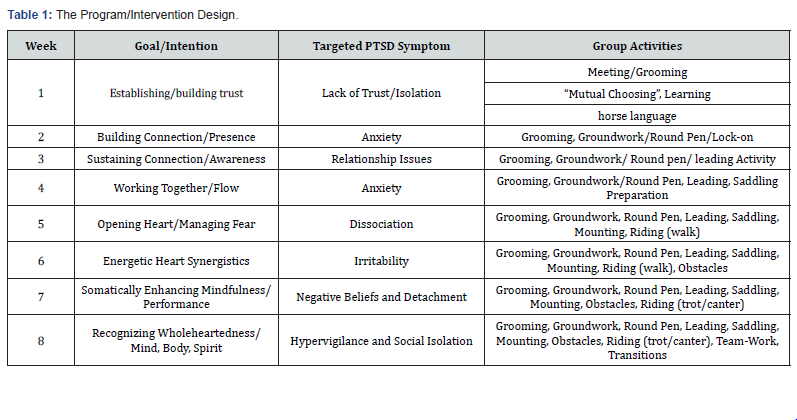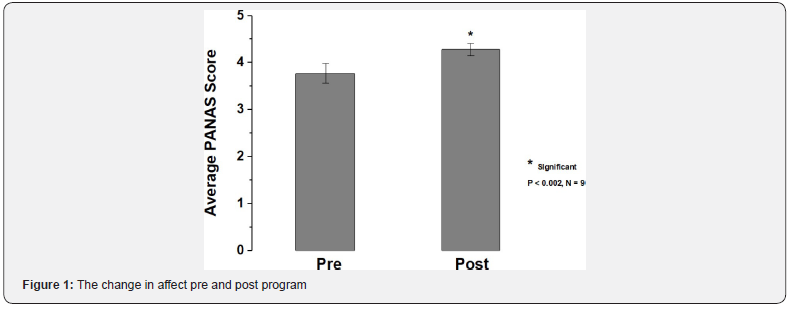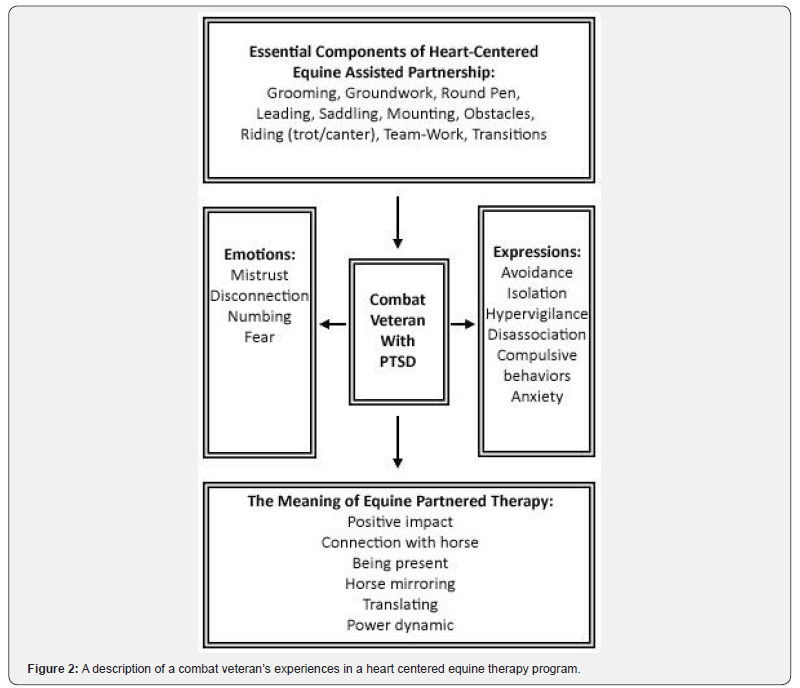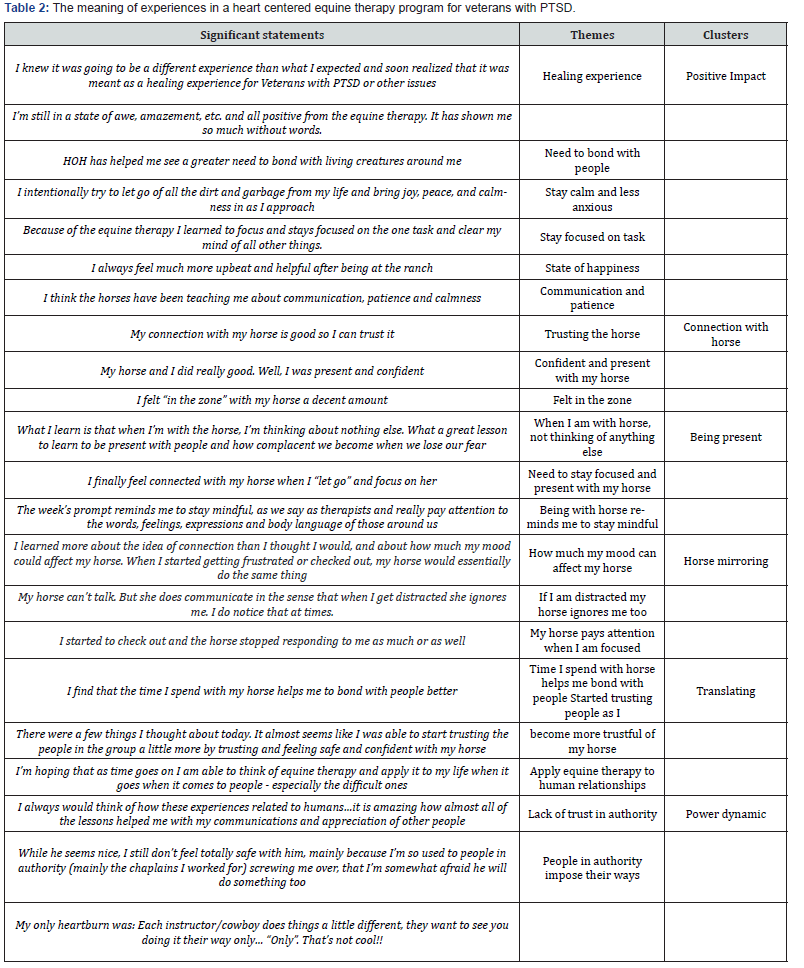A Mixed-Method Analysis of an Equine Complementary Therapy Program to Heal Combat Veterans- Juniper Publishers
Juniper Publishers- Journal of complementary medicine
Abstract
This study presents a mixed-methods analysis to
understand the healing experiences of veterans diagnosed with
post-traumatic stress disorder (PTSD) in a heart-centered complementary
therapy horsemanship program. This therapy was designed to address PTSD
symptoms and involved weekly activities involving small group and
one-on-one interactions with a horse and riding instructors. Previous
work by our group found that this program provided significant
improvement in the psychophysiological health of the participants. In
this stage, the following research question was addressed: How did the
veterans describe their healing experiences with horses in the program? A
cohort of 9 combat veteran participants were first analyzed using the
positive and negative affect schedule (PANAS) before and after each
weekly session of the 8-week program. The PANAS results revealed a
significant change in positive affect starting in week 2 (paired t test,
t = -2.76, P = 0.025). Weekly writings from participant’s journals were
analyzed qualitatively using a phenomenological method of inquiry. This
analysis resulted in a narrative integration of the significant
statements, formulated meanings, and a cluster of themes. The themes
centered around positive impact, connection with a horse, being present,
horse mirroring, translating, trauma, and power dynamics. These themes
described positive behaviors that resulted in reduced PTSD symptomology
and promoted the healing phenomenon.
Keywords: PTSD symptoms; Veterans; Horsemanship; PANAS; complementary treatment; Mix-methods research; Equine assisted therapy
Abbrevations:
PANAS: Positive and Negative Affect Schedule; PTSD: Post Traumatic
Stress Disorder; EPE: Equine Partnered Experiences; TBI: Traumatic Brain
Injury; HRV: Heart Rate Variability; HOH: Heart of Horsemanship
program; DSM-5: Diagnostic and Statistical Manual of Mental Disorders,
Fifth Ed.; PCL-5: PTSD Checklist for DSM-5; SSNI:
Serotonin-Norepinephrine Reuptake Inhibitors; EMDR: Eye Movement
Desensitization Reprocessing
Introduction
PTSD
There are more than 500,000 veterans who
participated in various US military wars over the past 60 years who
suffer from symptoms diagnosed as PTSD and traumatic brain injury (TBI).
It is becoming clear that military personnel exposed to combat
operations are at an increased risk for PTSD [1]. According to Makinson
& Young [2], “PTSD is a mental disorder characterized by a sudden
onset of symptoms due to environmental exposure to a psychologically
stressful event such as war, natural disaster, or sexual victimization”.
The DSM-5 handbook describes intrusion symptoms, avoidance, negative
alterations in cognition and mood, and alteration in alertness and
negativity [3]. Intrusion symptoms include the reoccurrence of the event
in thoughts, dreams, illusions, or flashbacks. Those suffering from
PTSD will also avoid thoughts and feelings connected to the event/people
or places that trigger recollections of the trauma and possess
negative alterations to include negative beliefs about oneself,
diminished interest in social activities, or detachment from others.
Veterans will express alteration in alertness and activity and exhibit
irritable behavior, insomnia, and hypervigilance. Most importantly is
that veterans who suffer from the impacts of PTSD experience an overall
impairment in their day-to-day living.
Treatment options
In 2010, the Department of Veterans Affairs and
Department of Defense released their recommended guidelines for
treatment of PTSD. Of many modalities for treatment, exposure therapy,
specifically prolonged exposure therapy, was recommended as an
evidence-based treatment option. Other modalities included: cognitive
processing therapy, stress inoculation training, treatment with
Serotonin-Norepinephrine Reuptake Inhibitors (SSRI), and eye movement
desensitization reprocessing (EMDR) treatment [4]. Until recently,
equine therapy has not been the center stage of treatment options
available for veterans.
Previous research
The authors have been conducting research with
military veterans since 2015 using equine therapy as a nonpharmacological
complementary approach to healing. The first
research stage employed a quantitative assessment measuring
Heart Rate Variability (HRV) to determine the physiological
changes occurring during a heart-based equine therapy program.
Veterans were also given a psychological self-assessment to
determine a positive and negative affect schedule (PANAS) of their
equine experience. Results were significant from the quantitative
perspective demonstrating a positive wellbeing outcome for
the participants [5]. To endeavor in further inquiry, the authors
shifted their emphasis to a mixed-method analysis based on the
data from weekly journaling and recorded observations.
History of healing veterans with horses
Since the fifth century B.C. horseback riding was used for
rehabilitating wounded soldiers [6]. For many years, animals have
been used for the therapeutic benefit of humans in a variety of
settings. For example, domestic animals are used to help medically
ill children in hospitals and the elderly in nursing homes, but it was
not until the 1960s that horses were used in the United States for
therapeutic purposes [7]. Horses have proven effective in working
in partnership with humans to aid the process of healing from
trauma, grief, depression, and other emotional challenges. Unlike
humans, they are not capable of hiding their emotions. In fact,
they are primarily emotional beings and respond to the stimuli
produced by emotional energy which begins from the heart [8].
Horses have abilities to interact with and heal humans. Like
humans, horses live in social herds. Horses are prey animals
making them hypervigilant to the intentions of those in the
environment for their survival. Horses are quick and instinctual
in sensing the emotional field around them. This helps encourage
veterans to develop trust, to operate with integrity and fairness
and to be clear in communication and intention. Horses enable
veterans to accept criticism and self-judgment. This had led to
veterans experiencing less anxiety, stress, emotional upheavals
and feeling more confident in the decisions they make [5].
Experiences with horses provides a safe place for addressing and
shifting the pain and suffering associated with PTSD.
Materials and Methods
findings were significant and a paper was published in the
Military, Veterans and Family Health Journal [5] regarding the
quantitative results. This paper provides an emphasis on the
qualitative analysis relating to the deeper human aspect of what
the experience meant to the veterans as they developed strong
bonds and partnerships with the horses and as a group.
Participant selection
The participants were recruited from a Southern California
Veterans center. The director of the Veterans Center was
instrumental in identifying candidates who were working with
traditional counseling therapy either in group or individually and
referred them to the horsemanship program. Space was limited to
nine in the cohort and the study team did not discriminate based
on gender, age, or which war situation contributed to their PTSD.
The ages ranged from 22 to 68 years and from Iraq to Vietnam
deployments. We purposely did not request their PCL-5 [10]
checklist scores or have them take any of the VA assessments
regarding their level of PTSD.
All participants signed liability releases, consent forms, and
photo release forms. They were informed regarding the research
protocol and had the option to not participate. However, all were
eager to participate and agreed to the weekly data collection
that included taking a positive and negative affect instrument
known as the PANAS (a validated instrument) [10] to determine
if they would self-report improvements in symptoms associated
with PTSD because of participating in the heart of horsemanship
partnership program.
Study design
The study was conducted over eight weeks with one half day
session each week. Participants arrived at the ranch in a van from
the Vet Center or separately in their own vehicle. Upon arrival
they would complete the 20 question PANAS questionnaire. The
wranglers/instructors, veterans and two researchers would
meet for about half hour in a circle to brief the group for the
day’s suggested activities. Each week included an opening circle
and meditation where participants checked in. Participation
was voluntary but most offered reflections of their current
psychological state. The meditation focused on attentiveness of
the heart and their body. A crystal bowl tuned to the heart was
played to conclude the opening circle and then the veterans left
the circle to go bond with and halter their horse. The sessions
ran from 9 am to 12 noon, with two hours of horse engagement
activities. We concluded with a closing circle at the end of each
3-hour session to allow for debrief and participant insight sharing.
The crystal heart bowl was played as a final note and the veterans
departed- often exchanging hugs and words with each other and
the wrangler/instructors.
Specific symptoms associated with PTSD guided the
curriculum design for each session and is outlined in Table 1. Each
veteran initially selected their own horse based on a perceived
felt energetic connection. They continued working with their
selected horse on a continuous weekly basis. Participants also
had an experienced individual wrangler/instructor who helped
guide them in getting acquainted with their horse and to ensure
their learning and safety. Sometimes veterans would join in all group activities such as obstacle training, and other times they
would work privately with their wrangler/instructor. The goals/
intentions of the weekly sessions were known and how each
veteran addressed them varied from individual to individual.

The purpose of this phenomenological study is to understand
how the interaction with equine partnered experiences (EPE)
helped veterans with PTSD heal. We addressed the following
qualitative question: How did veterans with PTSD describe
their healing experiences in a group structured heart-centered
horsemanship program?
Data analysis
Analysis was guided by the research question, the structured
weekly journal prompts, and Colaizzi’s [11] phenomenological
method of inquiry. There are seven procedural steps to Colaizzi’s
[11] method of data analysis which include
a) reading all the participant’s weekly journal entries to
acquire a feeling for them
b) extract significant statements from the transcriptions
that are related to the veteran’s self-reported healing process
c) formulate meanings or codes from the significant
statements.
d) repeat step 3 for each participant’s journals, and then
place the codes into clusters of themes based on frequency.
e) integrate all the results into an exhaustive description of
the healing process and program.
f) Attempt to reduce exhaustive description into the
unequivocal statement that is an identification of the
fundamental structure of the phenomenon.
g) Return the findings to one participant in the study for
interrater checking or informant feedback.
Results
PANAS
For the PANAS results, the affect scores (negative affect
converted to corresponding positive score) were averaged for the
before (pre) and after (post) weekly sessions and are displayed as
a bar graph in Figure 1. The subjects positive outlook improved
over the course of the program. A significant change in affect
occurred at week 2 using a paired t test (t = -2.76, P = 0.025) and
stayed significantly different for the rest of the program (t = -4.37,
P = 0.002). Week 1 showed improvement, but was not significantly
different (t = -2.00, P = 0.085, data not shown).

Qualitative coding meaning
Based on a related study description of hospital-related fears
for small children [12], the experience of a combat veteran with
PTSD in a heart-centered equine partnered therapy program
was outlined in Figure 2. These experiences in an equine therapy
program consisted of essential curriculum components, the
emotions and expressions elicited from the veterans, and the
meaning associated with the experience.

Essential components of heart-centered equine-assisted partnership
This study intentionally designed heart-centered curriculum
components to a heart-centered equine partnership around
the symptomology of PTSD. These included activities such as
grooming, groundwork, round-pen interactions, leading, saddling,
mounting, managing obstacles, riding (trot/canter), teamwork
exercises, and making riding transitions. These program
components are described by week in Table 1.
The ways in which combat veterans expressed themselves during the equine interaction
When each veteran interacted with their individual horse he
or she described emotions of mistrust and feeling disconnected
from the world. The veterans also described a feeling of emotional
numbing, unable to express his or her feelings in their daily
functioning.
Participants expressed themselves in behaviors
related to
avoidance and isolation, choosing to be alone with their horse versus
with the group. They explain feeling outside of their bodies
in a dissociative state disconnected from the present moment.
Compulsive behaviors and being hypervigilant to those around
them and his or her surroundings were shared consistent with
typical behaviors for the diagnosis of PTSD.
The meaning of a heart-centered equine partnered experience to combat veterans with PTSD
The meaning of an equine-partnered experience for combat
veterans with PTSD are defined by several significant statements
that consisted of six main clusters that came out of the qualitative
analysis: positive impact, connection with horse, being present,
horse mirroring, translating, and power dynamics (Table 2).

Positive impact
The cluster of positive impact consisted of six themes
describing an overall positive impact of participation. The theme
of healing experience describes how many of the veterans found
interaction with his or her horse to be a healing process. The
program also reaffirmed veterans need to bond with people. and
find connection. Staying calm and less anxious were intentionally
challenged to help the veteran find more peace, joy and calmness
to the experience, but also to their lives. Intention to focus on task
helped clear the veterans mind from other distractions in his or
her life. Finally, themes of communication and patience and overall
state of happiness were evident as the horse interaction allowed
the veteran to better communicate and provide an overall sense of
peace and happiness.
Connection with horse
The feeling of connection is one that many of us strive for.
Both horses and humans are social species, seeking connection
to others is an important part of our emotional and physical
well-being. Connection is a feeling, and so it can be described in
different ways. Veterans describe this connection as an awareness
of a presence with a sentient being. They describe that having a
connection allows them to trust his or her horse. And participants
feel accomplished when they are present and confident in their
ability with the horse. Over the course of the program, veterans
explain feeling in the “zone” in which they felt a oneness oftentimes
without thinking or trying too hard to do so.
Being present/mindfulness
The cluster being present/mindfulness explains how the
veteran felt grounded, in the moment and totally focused on the
present moment. For example, when committed to the entire
presence and behavior of the horse, the veteran forgets about
other stressors or anxieties in his or her life. They recognize that
intentional focus on the horse, allows a “letting go” to be present
around the horse. Reciprocally, being totally with the horse also
seems to reinforce personal mindfulness of those others around
him or her
Horse mirroring
Horse mirroring is the reflection of self in the horse’s emotions
and behavior. In other words, if the veteran noticed his or her
mood was poor the horse would respond accordingly poor. Also,
if the veteran bought daily living distractions such as family or
personal life into the interaction, the horse ignored the veteran.
Soon the veteran realized that the horse pays attention when the
combat veteran “shows up” to lead and is focused on the horse.
Translating
Applying program lessons to one’s personal life was described
in the cluster of themes as translating. In short, the veteran begins
to translate little lessons learned in interacting together with the
rest of his or her social world. Learning how to bond with the horse
seemed to reinforce a positive bonding with people. Similarly,
learning to overcome trust issues from his or her trauma, became
evident when the participant wholeheartedly trusted their horse.
Quite powerfully, the veteran changed psychosocially applying his
or her thoughts and behaviors to their interaction with human
relationships.
Power dynamics
Finally, for some veterans a cluster of themes around power
dynamics existed, expressing relational distrust of authority
figures such as the therapist, facilitators or wranglers. The veteran
expressed their lack of trust in authority, and that people in
authority impose their ways on them. The veteran had to change
their rigid ideas of how to do things as directed by an authority
figure, in this case the horse wranglers.
Discussion
The results offer a view of the experience and phenomena
of a heart-centered, equine-assisted partnership for veterans
diagnosed with PTSD. The PANAS results demonstrated a
significant improvement in affect. In our last study [5], it took 4
weeks to see a significant change in affect. Here we have more
evidence that it takes time (2-4 weeks) for the affect score to catch
up to the immediate change in HRV. While veterans expressed
behaviors and emotions consistent with a diagnosis of PTSD in the
qualitative observations and journaling (isolation, hypervigilance,
distrust, etc.) most participants shared positive outcomes of
participation, explained in the cluster of themes. For example,
the theme of positive impact defined by the ways in which the
participants experienced a favorable, helpful, beneficial outcome
of the program was consistent with Earles, Vernon, and Yetz’ study
[13] that showed Equine Partnering Naturally © programming
may be an effective treatment for anxiety and posttraumatic stress
syndrome for veterans with PTSD.
Similarly, participants defined and expressed their connection
with their horse. Some felt most connected when just standing or
walking with the horse while some connected while grooming. The
most common description of connection were moments of moving
in unity, a feeling of oneness and togetherness. Horse to veteran
connection has previously been documented in the Saratoga
War Horse Project [14] in which the Connection methodology:
nonverbal language of the horse in a predictable, sequential, and
repeatable method was used with a combat veteran to build a
horse-human connection with positive psychological functioning
outcomes and reduced PTSD symptomology.
Horses, are highly social, nomadic prey animals. They embody
many of the attitudes and skills that some humans spend their
lives searching for. One of the pluses of being “in the moment” is
the ability to act quickly in the face of danger, and sometimes more
importantly, to be able to let it go and go back to grazing.
Participants spoke of “being an outsider looking in”
and “losing
touch with reality”. This form of avoidance which presents itself as
dissociation or emotional numbing is common for survivors of
trauma [15].
Participants describe a realization in working with horses
that to form connection, stay present, and manage dissociation
they need to focus and concentrate on one thing at time. Zerubavel
and Messman-Moore [16] summarized well these phenomena.
Mindfulness is a strong treatment for dissociative behavior as
it removes one from the present moment, while mindfulness
cultivates the ability to stay in the moment.
Another cluster reported was horse mirroring. Zugich, Klontz,
and Leinart [17] describe the horse as mirrors in which they can
“provide accurate and unbiased feedback, mirroring physical
and emotional states of the veteran, providing clients with the
opportunity to raise their awareness and to practice congruence
between their feelings and behaviors”. Veterans describe a lack of
presence impacted his or her horse’s behavior, providing real time
feedback helping the veteran autocorrect and stay present with
both his or her feelings and behaviors.
One of the most salient findings of the study was the way in
which participants transferred their learning from the program
and his or her horse and hoped to use the new awareness in their
lives. A parallel study
[18] using outdoor based adventure experiences to treat
veterans with PTSD found similar findings regarding veterans’
renewed ways of translating the experience to their relationships.
This is similar to a recent equine related study [19] for student
veteran nursing students who translated interactions with horses
to their personal and academic lives.
Finally, an unexpected finding was concern around power
and authority as veterans described a lack of trust and frustration
at times with the supervising clinical therapist and wranglers
involved in the group facilitation. Johnson and Lubin [20] argue
that this type of transference reaction to clinical leadership will
also reflect past experience with authority especially relative to
the trauma. And this lack of trust in authority and intolerance
of imperfection is documented in Alford, Mahone & Fielstein’s
[21] work with Vietnam veterans with PTSD. Alternatively, some
participants respected and trusted authority, consistent with
Turchik and Wilson’s [22] research on military obedience to
authority.
Special considerations
Moving forward it’s crucial that health care practitioners and
educational institutions be trained in cultural competency to
understand veteran populations. What may seem like a defiance
of instruction might be a
lifesaving way of “being” to a veteran. One veteran described
his frustration in being asked to look forward in working with
his horse instead of at his feet. Researchers learned later he
had worked in explosives detection and his squad’s lives were
dependent on his looking down. He had carried this attitude with
him into his civilian way of being. Atuel and Castro [23] provide
a strong overview of military cultural competency to include
military culture as it applies to therapeutic work for veterans.
Conclusion
In conclusion, the goal of this study was to explore the
qualitative aspects of a heart-centered equine therapy program.
Previous work by the authors showed psychophysiological
improvement in veterans participating in the 8- week program [5].
The PANAS results showed a significant improvement in affect in
the participants by the second week of the program. A qualitative
evaluation of the participants journal entries and research
observations revealed six clusters associated with the meaning
of a heart centered equine assisted partnership. The combat
veteran with PTSD may experience differing levels of interaction
and change in working with an equine partner. His or her positive
impact may be leveraged by the ability to connect with the horse,
staying present, and translating the learnings to interactions with
people. More negative expressions and behaviors due to PTSD
may be observed regarding questioning authority figures and the
symptomology related to trauma such as distrust, social anxiety,
isolation and hypervigilance.
The veteran came to recognize that his or her affect and
behavior is directly reflected or mirrored in the
horse’s behavior, such that the combat veteran became selfaware
of his or her attitudes and behaviors and self-corrected to
create a stronger bond with their horse. Thus, the phenomenon of
equine partnership creates psychosocial, physical, and emotional
changes that may serve as a non-pharmacological approach to
treatment for PTSD.
For more
articles please click on Journal of Complementary Medicine &
Alternative Healthcare




Comments
Post a Comment